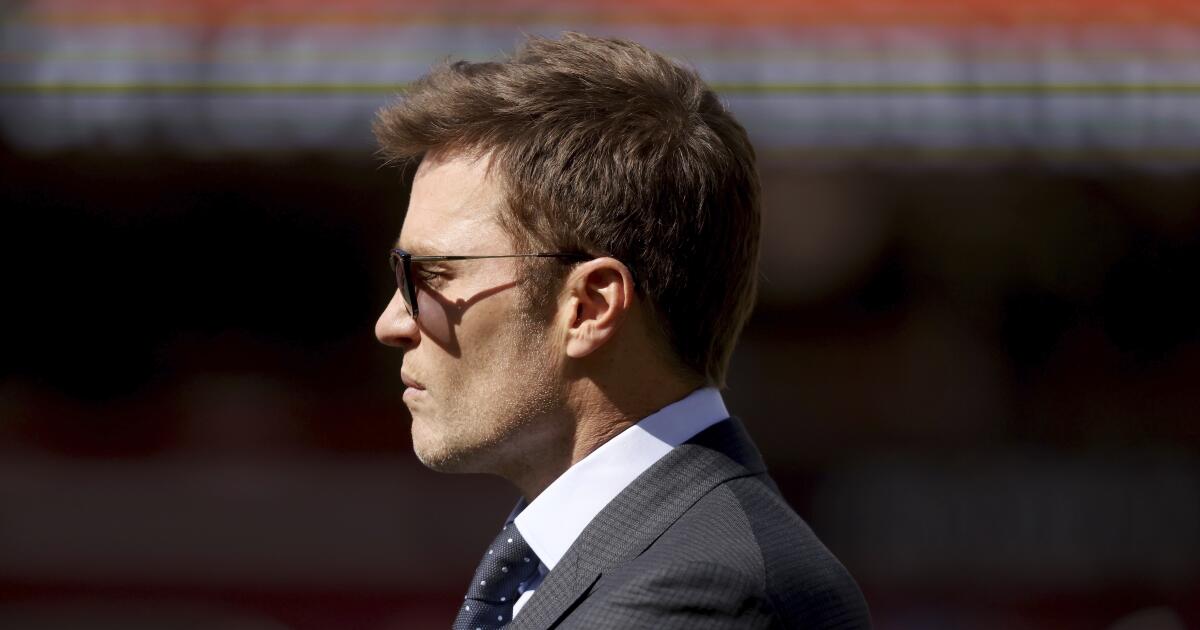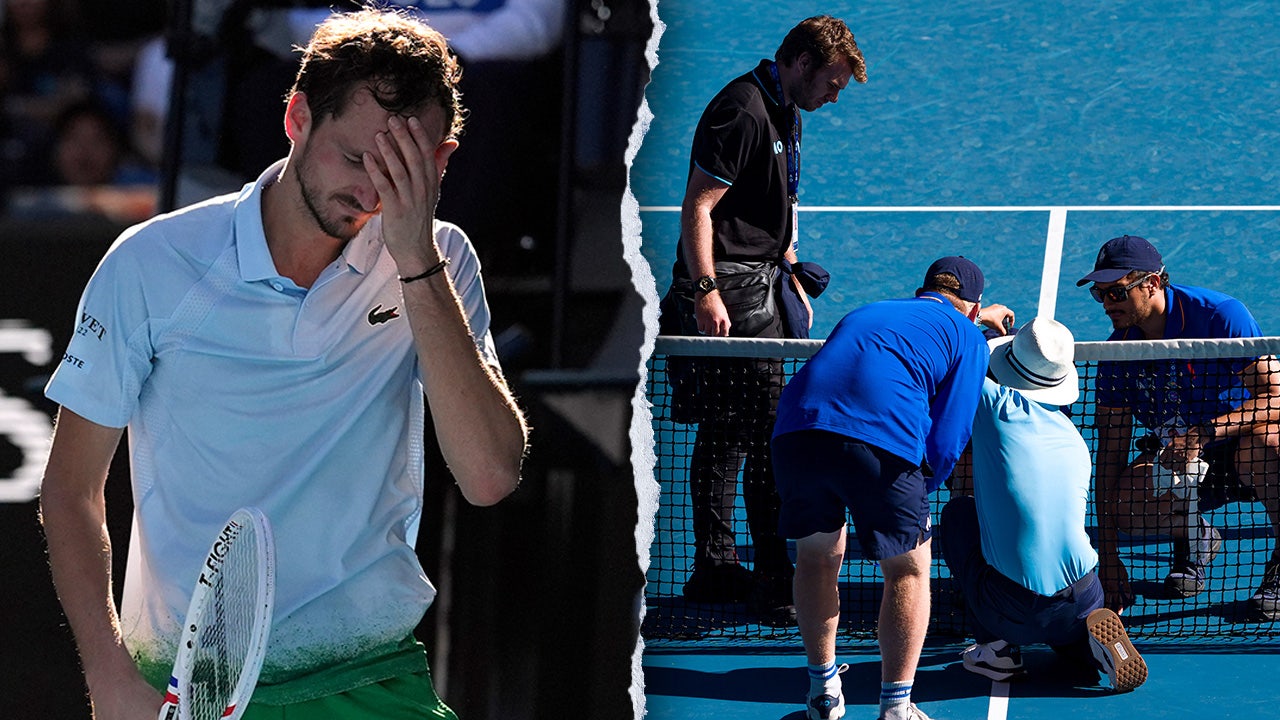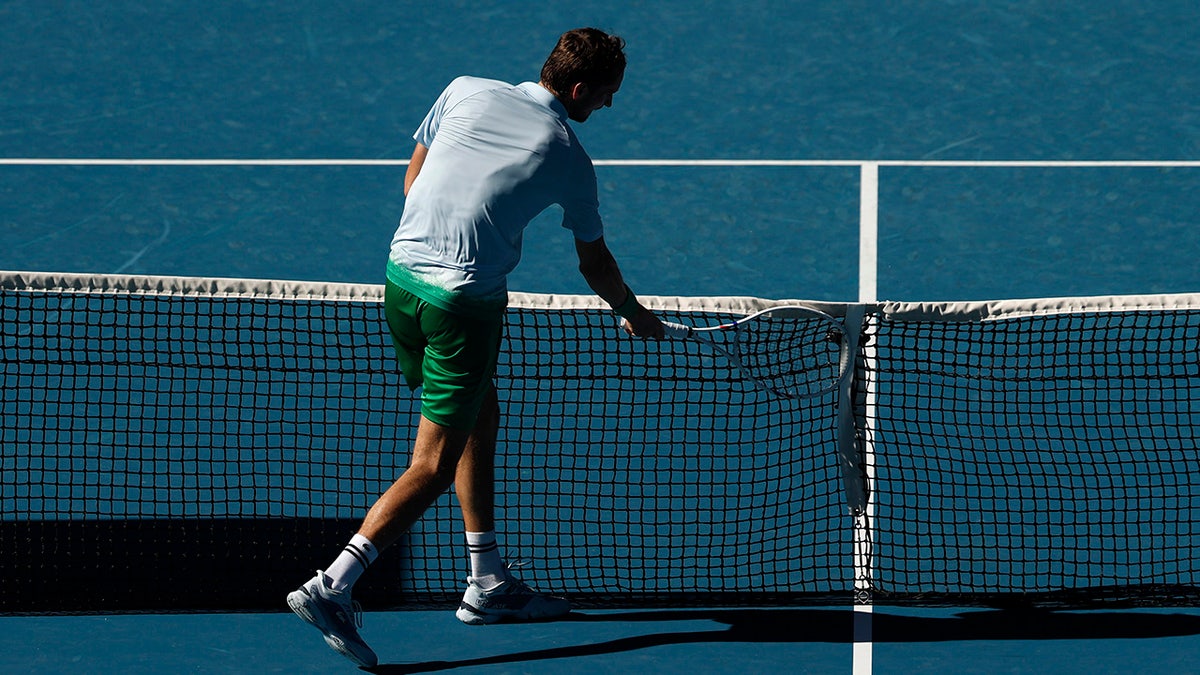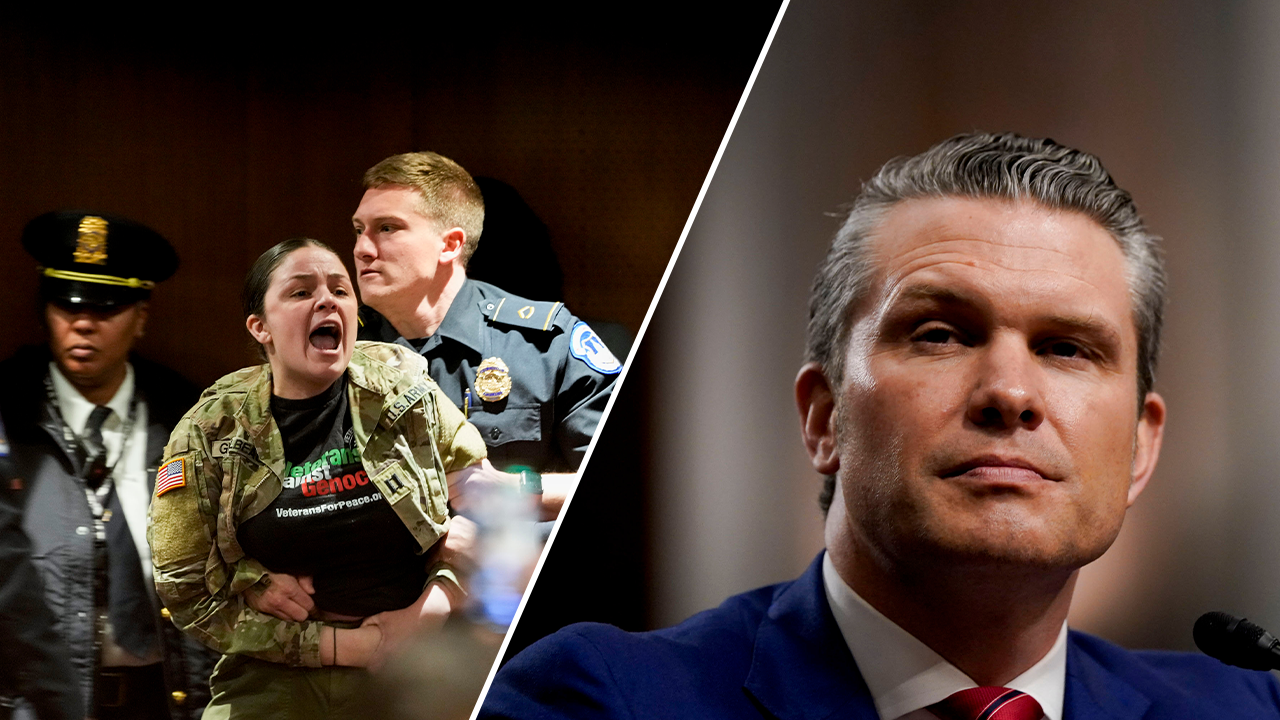Sports
NFL Network host apologizes after criticizing Tom Brady's broadcasting debut: 'I am rooting you on'

Tom Brady seemed a bit nervous.
That’s right. The man who won seven Super Bowls, earned three league MVP awards and set numerous quarterbacking records during a 23-year NFL career — not to mention sat there and withstood hours of raunchy barbs at his expense during a recent Netflix roast — didn’t completely kill it during his regular-season debut as a color commentator for Fox.
Working with play-by-play announcer Kevin Burkhardt during the Dallas Cowboys-Cleveland Browns Week 1 matchup Sunday, Brady displayed the kind of football knowledge one would expect from the player largely regarded as the sport’s GOAT.
But one game into his 10-year, $375-million contract with Fox, Brady is being criticized for a delivery that seemed somewhat robotic and showing a level of emotion that resembled that shown by former New England Patriots coach Bill Belichick during postgame news conferences.
Just before halftime, for example, Dallas kicker Brandon Aubrey lined up to attempt a 71-yard field goal, after having a record-tying 66-yarder negated by a delay-of-game penalty. While Burkhardt marveled at the idea of even attempting a kick from such a distance, Brady commented on how the Cowboys need to be prepared in case the kick comes up short and, after the Browns called timeout, that “maybe everyone’s gonna rethink this one.”
The clip was shown on NFL Network’s “NFL RedZone,” with host Scott Hanson calling out Brady for his apparent lack of enthusiasm.
“Oh, come on,” Hanson said. “Brady’s gotta get more excited than that in the booth.”
On Monday morning, Hanson reposted a clip of his comment, along with an apology to Brady.
“This was unfair & inconsiderate by me,” Hanson wrote. “Yes, I was saying it tongue in cheek — but I didn’t calculate how it may come across. @TomBrady, I apologize. I promise I am rooting you on in this new venture!”
Incidentally, Brady’s analysis of the situation was correct. Dallas actually did rethink the field-goal attempt and instead ended the half with a Dak Prescott pass attempt to the end zone that fell incomplete and ended the half.
Another awkward moment occurred on camera, when Brady’s attempt at to fist bump with Mike Pereira wasn’t noticed for several seconds by the rules analyst. “Oh, don’t leave me hanging,” joked Brady, who was eventually bumped back by Pereira.
To be fair, Brady didn’t have a lot to work with during his regular-season debut as an NFL announcer. The game itself was a dud, with the Cowboys winning in blowout fashion.
Brady did have his moments, like when he made an apparent reference to Belichick in saying, “I played for a coach that didn’t mind cussing his players out,” then explained why he thought that wasn’t such a bad thing.
“If you want to be a great player, you want to be pushed, you want to be challenged, you want to be criticized,” Braday said.
He added: “I was the beneficiary of a lot of that hard coaching. … Discipline and accountability are mainstays in any successful organization, and I have no problem with any coaches that feel like they need to tell their player the truth, ‘cause you just don’t get a lot of truth all the time as an NFL player.”

Sports
Rams to have 'sense of urgency' in slowing Saquon Barkley, Eagles

It was an embarrassing defeat, a night when Philadelphia Eagles running back Saquon Barkley dominated the Rams.
On Nov. 24, Barkley rushed for 255 yards and scored on runs of 70 and 72 yards in a 37-20 victory over the Rams at SoFi Stadium.
The defeat marked a turning point for the Rams.
Coach Sean McVay challenged his players to give their best effort over the final 39 days of the season. The Rams reeled off five consecutive victories before McVay rested starters in a season-ending loss to the Seattle Seahawks.
“When you have humbling experiences, with the right kinds of people, those are where the real growth [opportunities] exist,” McVay said Tuesday during a video conference with reporters, adding, “A lot of the scars that we’ve had as a team have been what led us to the point where we’re at.”
The Rams, coming off a dominating NFC wild-card victory over the Minnesota Vikings, are preparing to face Barkley and the No. 2-seeded Eagles in a divisional-round game on Sunday at Lincoln Financial Field in Philadelphia.
The Eagles advanced by defeating the Green Bay Packers, 22-10, on Sunday.
“They’re real,” McVay said of Eagles, adding, “They’re in this position for a reason.”
The Eagles feature Barkley, quarterback Jalen Hurts, receivers A.J. Brown and DeVonta Smith, tight end Dallas Goedert and, perhaps most importantly, one of the NFL’s best offensive lines.
Vic Fangio coordinates a defense that gave up only one touchdown and intercepted three passes against the Packers.
But Barkley is the biggest star on a team full of them.
The seventh-year pro, in his first season with the Eagles, rushed for 2,005 yards and 13 touchdowns.
Eagles running back Saquon Barkley scores on a 70-yard touchdown against the Rams in the third quarter at SoFi Stadium in Week 12.
(Wally Skalij / Los Angeles Times)
A good chunk came against the Rams.
So how must it be different on Sunday, when the Rams face a running back who rushed for 119 yards in 25 carries against the Packers?
“Our sense of urgency will be appropriate for the task at hand,” McVay said.
The Rams displayed an overwhelming pass rush against the Vikings — they tied an NFL postseason record with nine sacks — but neutralizing Barkley will be the key against the Eagles, Rams players said.
“Stopping Saquon and being able to get to some of the positions we were in tonight,” defensive lineman Braden Fiske said after the victory over the Vikings. “Getting to be able to rush the passer. I mean that’s what we got to do, get them into third and longs and keep them out of third and shorts.”
The Eagles offense, with Barkley and other weapons, “can really do damage at any time,” safety Quentin Lake said.
“We’re going to come up with a good game plan to make sure that we can limit the explosive plays,” Lake said. “Obviously, limit Saquon Barkley because we know how dangerous he is. And somehow, some way, find our opportunities to make plays on the ball.
“And if we do those things, we’ll have a good chance of winning.”
Etc.
Rams tight end Tyler Higbee, who suffered a chest injury against the Vikings, was released from the hospital and returned to Los Angeles on Monday night with the team. McVay said Higbee was taken to the hospital after spitting up blood. McVay had no other update but Higbee “has full expectation that he’ll be ready to go” on Sunday, McVay said. McVay had no update on cornerback Ahkello Witherspoon (hamstring). … Having left fire-ravaged Los Angeles for Arizona to prepare for their wild-card game, McVay said the Rams planned to remain in Southern California before leaving for Philadelphia on Saturday. “I’m very hopeful that we’ll be able to be here this week,” he said, adding, “All of our expectations for the time being are that we’re going to be able to have our preparation here.”
Sports
Sam Darnold coming up short in loss to Rams has major implications for Vikings’ future at QB

GLENDALE, Ariz. — The look on Zygi Wilf’s face said it all. It was as if the Minnesota Vikings owner and chairman had just watched a horror movie with a gutting ending. He exited the locker room, stood for a few seconds and stared blankly at the crowd of people in front of him. His son, Jonathan, pointed him toward a long hallway. And off he went slowly into another offseason.
How did this end so abruptly? How did a 14-win Vikings team oscillate so quickly from being a potential No. 1 seed to losing in the wild-card round? Wilf’s mind turned with questions such as these.
None of them, though, were as confounding as this one: What happened to quarterback Sam Darnold?
Two weeks ago, Darnold’s Vikings teammates were dousing him with water bottles as part of a locker-room celebration following a win at U.S. Bank Stadium. Now, here they were Monday night at State Farm Stadium, zipping up their suitcases and heading for the buses after a brutal 27-9 loss to the underdog Los Angeles Rams.
GO DEEPER
Rams down Vikings 27-9 in wild-card game for date with Eagles: Takeaways
The dichotomy between the two scenes was as stark as it was disorienting. In the first snapshot, the 27-year-old Darnold seemed to have completed a career transformation and galvanized an organization in the process. In the second, it felt fair to wonder how much of Darnold’s impressive play this season was a mirage.
“I think it’s very important we all think about Sam’s body of work,” Vikings coach Kevin O’Connell said postgame. “It did not work out in the end, and I think Sam would be the first one to tell you (he could have played better).”
After a loss like this one, there are typically multiple culprits. The offensive line is another obvious one for Minnesota. The Rams sacked Darnold nine times, tying an NFL playoff record. Furthermore, 12 Rams defenders generated at least one pressure, according to Next Gen Stats, their most in a game since Week 6 in 2021.
Hoecht throws up the “LA” after the Rams latest sack
📺: #MINvsLAR on ESPN/ABC
📱: Stream on @NFLPlus and ESPN+ pic.twitter.com/iWM1Pofp0U— NFL (@NFL) January 14, 2025
Allocating cap space and draft capital to interior offensive linemen will be a priority this offseason. O’Connell suggested as much Monday night.
Still, that concern pales in comparison to the importance of what happens at quarterback — and what that means for everything else — which is why Darnold’s drop-off over the last two weeks is so jarring.
After playing well enough over the first 16 games to lead the Vikings to a 14-2 record and legitimately be in the conversation for NFL MVP, Darnold struggled mightily in the regular-season finale, a 31-9 loss in Detroit. Against the Lions, he completed just 18 of 41 passes for 166 yards, posting his third-worst passer rating (55.5) and his highest bad-throw percentage of the season (34.2).

GO DEEPER
Did Vikings’ struggles against Lions show a blueprint for how to slow down Sam Darnold?
Those troubles continued against the Rams. His numbers — 25-for-40 passing for 245 yards, a touchdown and an interception — belied Darnold’s level of comfort. He misplaced multiple throws. Darnold, who so often this season had been pinpoint accurate, threw behind his receivers. He spun out of the pocket but failed to get the ball off. His eyes often scanned from right to left too quickly. His feet swiveled back and forth constantly. He tried to evade pass rushers, who engulfed him almost every time.
Darnold’s system malfunctioned in almost every regard. When it wasn’t his vision, it was his footwork. When it wasn’t his vision or his footwork, it was his arm.
“Left too many throws out there that I would usually make,” he said afterward.
Had he said that earlier in his career in New York or Carolina, some might have laughed. But this season, while entrusted in O’Connell’s scheme and developmental process, he proved over a meaningful sample size that he could progress in rhythm, deliver the football accurately and withstand pressure.
Darnold had also displayed resilience, navigating a difficult midseason stretch against the Colts and Jaguars during which he threw five interceptions. The way he responded to those tough film sessions, throwing 18 touchdowns and two interceptions in the ensuing seven games, showed just what he was capable of.
In late December, The Athletic’s Dianna Russini reported, “After conversations with a team source, one thing is clear: The Vikings want Darnold back in Minnesota for 2025.” Separately, another Vikings staffer texted, “I hope we can keep him.” Darnold’s MVP odds climbed. Against the Packers in the team’s final home game of the season, he completed 33 of 43 passes for 377 yards, three touchdowns and an interception and was soaked by teammates afterward in the locker room.
The Sam Darnold experience continues. pic.twitter.com/k5db9DYdtp
— Alec Lewis (@alec_lewis) December 30, 2024
This 2024 Vikings season, billed as a transition year toward a more flexible future around rookie quarterback J.J. McCarthy, had exceeded even the rosiest expectations.
“Outside of these walls, nobody really believed in him,” running back Aaron Jones said of Darnold at the time. “Nobody gave him a chance. But he’s proving everybody wrong.”
That was the crescendo, a byproduct of an infrastructure optimized in Darnold’s image. At the time, the Vikings staff reiterated the role that rhythm and timing played in Darnold’s success and how important it was for his feet and eyes to sync.
Buried in the jargon was an important reality: Darnold trusted the play calls and reads so much that it was more about sticking to a specific timing than observing the field and making decisions based on what he saw. The best way to sum up his struggles in Detroit and Arizona was an interruption in timing. Both the Lions and Rams affected Darnold’s ability to climb up in the pocket, and both teams mixed in countless stunts and exotic pressures to keep Darnold from being comfortable, assessing the picture downfield and throwing.
There were numerous examples from Monday night. Early in the second quarter, Darnold dropped back and eyed the right sideline. Rams defensive lineman Braden Fiske pushed Vikings left guard Blake Brandel toward Darnold, who side-stepped and kept his eyes on receiver Jordan Addison, while receiver Jalen Nailor was open crossing the field. Darnold hurled a pass in Addison’s direction. But the ball was late and behind Addison, and it was intercepted by Rams cornerback Cobie Durant.
Later in the quarter, the Rams blitzed safety Quentin Lake from depth. He squeaked past right guard Dalton Risner, forcing Darnold to step up and move his vision from right to left. Uncertain with what he was seeing, he looked back to his right. But before he could release the ball, another blitzer, Rams cornerback Ahkello Witherspoon, speared him in the back. Darnold fumbled, and Rams edge rusher Jared Verse recovered and rumbled 57 yards for a touchdown, extending Los Angeles’ lead.
JARED VERSE SCOOP AND SCORE!
📺: #MINvsLAR on ESPN/ABC
📱: Stream on @NFLPlus and ESPN+ pic.twitter.com/bXLHmOUaQW— NFL (@NFL) January 14, 2025
“There are some examples where, when you go back and watch the tape in an air-conditioned room tomorrow, it’s going to feel like, ‘Man, why didn’t I just do this or that?’” O’Connell said. “But it’s hard in the moment. It’s hard with how fast things happen out there.”
Good quarterbacks have the arm and the athleticism, especially in the modern NFL, but the mind is what separates the top-tier QBs. Matthew Stafford’s operating capacity on the other side of the field validated this, and Monday night substantiated a popular opinion regarding the Vikings’ future: Franchise-tagging or extending Darnold, who is set to become a free agent, does not make sense with the team’s needs elsewhere, especially on the interior of the offensive line.
Moving on from Darnold would, of course, raise questions. How ready is McCarthy? Which veteran option might the Vikings pair with McCarthy? And how would O’Connell feel about having to build up an entirely new quarterback option?
These are vastly different questions from the ones on Wilf’s mind as he wound his way through the bowels of the stadium Monday night. But they’ll soon be on his plate following a wildly successful season that ended in a disappointing flash, a roller-coaster ride for a quarterback who could not polish off the progress he’d built.
(Photo: Christian Petersen / Getty Images)
Sports
Daniil Medvedev smashes racket, camera during fiery outburst as he avoids Australian Open upset

Top-ranked tennis pro Daniil Medvedev destroyed a camera and his tennis racket as he faced what could have been a monumental upset in the Australian Open by a wild-card entry ranked 418th in the first round of the Grand Slam tournament on Tuesday.
Medvedev’s outburst came during the third set when he lost a 13-stroke back-and-forth with Thailand’s Kasidit Samrej to fall behind 40-15. With Medvedev up at the net, Samrej’s shot clipped the net to go beyond Medvedev’s reach in a direction he clearly could not have anticipated.
Daniil Medvedev reacts during his first-round match against Kasidit Samrej at the Australian Open in Melbourne, Tuesday, Jan. 14, 2025. (AP Photo/Ng Han Guan)
Then Medvedev, a three-time Australian Open finalist, unleashed his anger on the net, smashing his racket several times.
In the process, Medvedev destroyed his racket and a camera that was situated directly in his path of destruction.
Staff quickly rushed to replace the broken camera and clean up the debris on the court. Medvedev was given a code violation warning for racket abuse from the chair umpire.

Daniil Medvedev smashes a TV net camera with his racket as he has lost the third set against Kasidit Samrej in the men’s singles first-round match at Australian Open on Jan. 14, 2025. (Daniel Pockett/Getty Images)
COCO GAUFF DELIVERS 6-WORD MESSAGE FOR THOSE DEALING WITH LA WILDFIRES AFTER AUSTRALIAN OPEN WIN
Medvedev dropped the set to trail 2-1, and it looked as though the No. 5 ranked player would face elimination. But Medvedev quickly turned things around to win the following two sets 6-1, 6-2, and advanced to the second round.
“In the end of last year, this match, I probably would have lost it,” Medvedev said after the match. “New year, new energy.”

Daniil Medvedev’s outburst came during the third set when he lost a 13-stroke back-and-forth with Thailand’s Kasidit Samrej. (Daniel Pockett/Getty Images)
Medvedev is hoping to start out the 2025 season with a win in Melbourne. A three-time finalist, including in last year’s tournament, Medvedev has never won the Australian Open. His biggest challenger will be Novak Djokovic, who has won the most Australian Open titles than any other men’s player with 10.
The Associated Press contributed to this report.
Follow Fox News Digital’s sports coverage on X, and subscribe to the Fox News Sports Huddle newsletter.
-

 Health1 week ago
Health1 week agoOzempic ‘microdosing’ is the new weight-loss trend: Should you try it?
-
/cdn.vox-cdn.com/uploads/chorus_asset/file/25822586/STK169_ZUCKERBERG_MAGA_STKS491_CVIRGINIA_A.jpg)
/cdn.vox-cdn.com/uploads/chorus_asset/file/25822586/STK169_ZUCKERBERG_MAGA_STKS491_CVIRGINIA_A.jpg) Technology6 days ago
Technology6 days agoMeta is highlighting a splintering global approach to online speech
-

 Science3 days ago
Science3 days agoMetro will offer free rides in L.A. through Sunday due to fires
-
/cdn.vox-cdn.com/uploads/chorus_asset/file/25821992/videoframe_720397.png)
/cdn.vox-cdn.com/uploads/chorus_asset/file/25821992/videoframe_720397.png) Technology7 days ago
Technology7 days agoLas Vegas police release ChatGPT logs from the suspect in the Cybertruck explosion
-

 Movie Reviews1 week ago
Movie Reviews1 week ago‘How to Make Millions Before Grandma Dies’ Review: Thai Oscar Entry Is a Disarmingly Sentimental Tear-Jerker
-

 Health1 week ago
Health1 week agoMichael J. Fox honored with Presidential Medal of Freedom for Parkinson’s research efforts
-

 Movie Reviews1 week ago
Movie Reviews1 week agoMovie Review: Millennials try to buy-in or opt-out of the “American Meltdown”
-

 News7 days ago
News7 days agoPhotos: Pacific Palisades Wildfire Engulfs Homes in an L.A. Neighborhood














